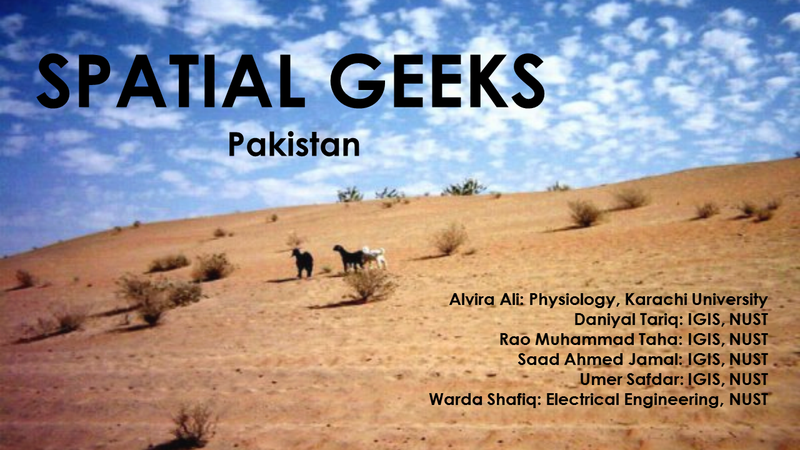Spatial Geeks | Bring Your Own Solution
Awards & Nominations
Spatial Geeks has received the following awards and nominations. Way to go!
The Challenge | Bring Your Own Solution
Follow your brain and your heart, and present a solution ofyour own choosing!
Project Aab-e-Hayat (Water for Life)
We are predicting drastic climatic conditions in Thar, Pakistan, from a General Circulation Model (GCM) based on the previous data available from multiple resources.

Idea:
Use of General Circulation Model (GCM) for predicting the next big climatic hit in Tharparkar, Sindh, Pakistan.
Background:
Tharparkar district faced major drought conditions in 2000, 2001, 2014 and 2015. Based on the available data of climatic conditions, we used a General Circulation Model (GCM) that employs a mathematical model of the general circulation of planetary atmosphere or ocean. GCMs and global climate models are used for weather forecasting, understanding the climate and forecasting climate changes. By the use of the obtained GCM, we predicted about the next severe strike of weather in the region of Tharparkar.
Implementation:
By using the Geographic Information System (GIS) and other signifcant parameters of the region and population in Tharparkar, Sindh. Our planning proposes noteworthy approaches for managing the drought conditions and providing the local population with maximum aid in minimal expenditure, utilizing the naturally existing resources.
Challenges:
The sacrcity of relevant data and inavailability of reliable resources on the recording portal for temperature, rain fall and morality rates for Tharparkar, has been a limiting factor.
Resources:
- Anjum, S. A., Saleem, M. F., Cheema, M. A., Bilal, M. F., & Khaliq, T. (2012). AN ASSESSMENT TO VULNERABILITY, EXTENT, CHARACTERISTICS AND SEVERITY OF DROUGHT HAZARD IN PAKISTAN. Pakistan Journal of Science, 64(2).
- Edward A. Downing. (1994). Force provider: An emergency response system. Desalination, Volume 99, Issues 2–3, ,Pages 409-421.
- Khan, M. A., & Gadiwala, M. S. (2013). A Study of Drought over Sindh (Pakistan) Using Standardized Precipitation Index (SPI) 1951 to 2010. Pakistan Journal of Meteorology, 9(18).
- Malik, S. M., Awan, H., & Khan, N. (2012). Mapping vulnerability to climate change and its repercussions on human health in Pakistan. Globalization and health, 8(1), 31.
- Marksim GCM (http://gisweb.ciat.cgiar.org/MarkSimGCM/#tabs-3).
- Pakistan Meteorological Department, PMD.
- Pasha, M., Ali, A., & Waheed, A. (2015). Sindh drought 2014—Pakistan: was it a natural or a man-made disaster. Am J Soc Sci Res, 1(1), 16-20.
SpaceApps is a NASA incubator innovation program.